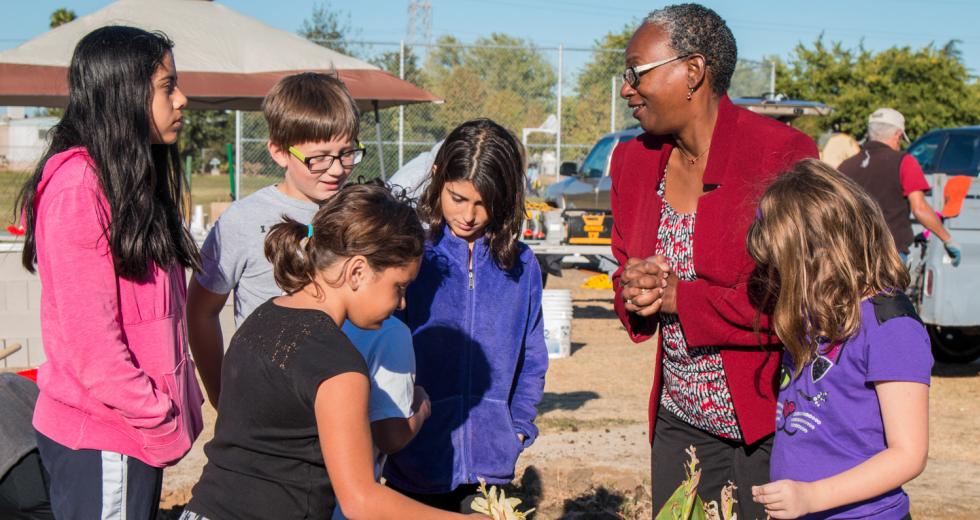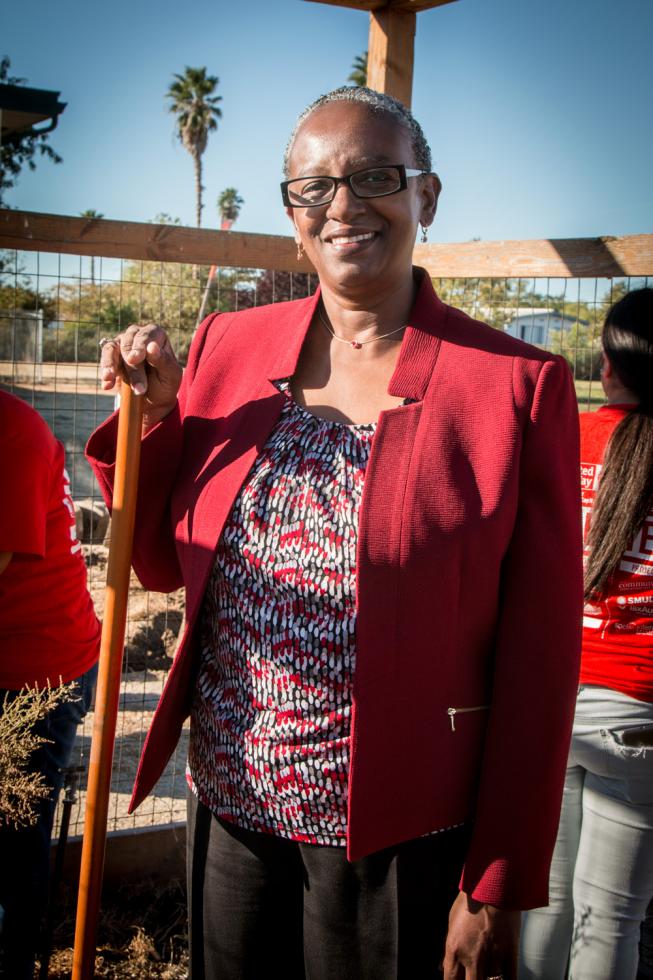A young girl, about 10 years old, torpedoes down the concrete walkway at Robertson Park toward Stephanie McLemore Bray, CEO of United Way California Capital Region. The girl’s brown eyes shine with excitement. “You spoke at my school,” she says, and of the swag she received: “I still have my water bottle and use it every day.”
Bray, here at the park in north Sacramento for the Summer Meals Kick Off event held last June, is delighted. The girl had listened attentively six months earlier when Bray spoke at a Taylor Street Elementary School assembly about the importance of staying hydrated. The Young Leaders Society, a United Way subset of young professionals (ages 21 to 40) spearheaded by Bray, raised $27,000 to install hydration stations in each of the six schools in the Robla School District in north Sacramento. Having learned that dehydration was the most common malady seen by the Taylor Street Elementary School’s nurse, the YLS also purchased 2,300 reuseable water bottles, personalized each one with students’ names and tucked handwritten notes of encouragement inside.
“Board members tend to be older, and not diverse in terms of race, gender, ethnicity or age — that’s not unique to United Way.”
For Bray, the success of a United Way program led by young people proves her efforts to re-energize the chapter are on track: “It took me a little bit to get the United Way board to understand the need to reach out to the younger generation,” she says, smartly dressed in one of her signature pant suits. Though she doesn’t fault the institution, saying that in general, “board members tend to be older, and not diverse in terms of race, gender, ethnicity or age — that’s not unique to United Way.”
As evidence of the work to be done, there are only about 20 attendees at the event to kick-off free summer meals for those 18 and younger — beyond staff affiliated with United Way or one of the booths sponsored by Safe Credit Union, Mutual Assistance Network, Health Net, Sacramento Food Bank, Sacramento Metropolitan Utility District and others. Bray planned for a crowd of 150 to 200.
“It was a well-done event but we need to change the language, broaden and be innovative in terms of outreach,” she says. She pauses. “People are not used to United Way delivering direct service.”
A New Strategy
If recruiting and empowering millennials and gen-Xers challenged the status quo, there’s no telling what will happen in coming months as Bray’s bold new vision for United Way unfolds. Square One, her 20-year master plan to “end poverty through education” will disrupt the venerable organization while also ensuring that United Way remains a major player in local philanthropy.
Of the evolution in perception that is underway, Bray says: “People still think of us as an organization that passes money through to other nonprofits. But we’re becoming a backbone organization that changes systems.”
United Way of America began in 1913 in Cleveland and is one of the oldest charities in the U.S. For more than 90 years, the California Capital Region branch, like other charities in the national network, has been best known for annual workplace fundraising campaigns. Employee donations were pooled, and panels comprised of select community volunteers decided which pre-certified local nonprofits should receive grants. But Bray, who was named CEO in 2013, says a new fundraising and distribution model is needed for United Way to effectively lift people out of poverty.
First, though, Bray has to connect with the people she intends to serve and convince them United Way is here to help. At Robertson Park, Bray scans the Summer Meals Kick Off event. Pop-up vendor booths line the concrete walkway. A DJ spins tunes near the table offering free lunches of barbeque chicken, hot dogs, salad and fresh-picked strawberries. Bray stands in the shade of a black locust tree to address the small crowd. “Couldn’t ask for a better day,” she says to the small crowd. “There’s a nice breeze. Best of all, we have you, the community.”
The following Wednesday, as Bray maneuvers her Mini Cooper to the neighborhood of Robla, at the northern edge of Sacramento, she reflects on the low turnout. She says that the Summer Meal Kick Off was a first for the Capital Region United Way and there is much she can learn from it.
Education is Key
Bray’s resilience in the face of obstacles is a trait that her father carefully cultivated. As a child, she watched her parents’ economic status rise as her father achieved his education goals. The first African-American state trooper in Trenton, New Jersey, he worked night shifts while attending college to earn a bachelor’s degree. Later he attended law school, with Bray in tow.
While in middle and high school, after her father had become an attorney for the school board, Bray would work for him during summer vacations. He paid her $75 per week to write up synopses of his meetings.
“He would critique it for grammar, spelling, facts and ideas,” she says. “He would talk with me about it and have me rewrite it until it was perfect.”
Bray’s early introduction to higher education as an economic equalizer has stuck with her to this day. “We know all parents have the same aspirations for their children, but they may not have the same resources,” she says. “In our region, almost half of the people who live here don’t have the resources to sustain themselves if an emergency strikes. They are liquid asset-poor. They can’t survive if they lose their job. That’s unacceptable.”
Bray determined that the best way to tackle systemic poverty would be to change the way that services are delivered to those most in need. The Square One project, Bray’s master plan for refocusing United Way’s resources, is structured in four parts: keeping children in school, keeping them on track academically, ensuring kids and their families are held responsible for meeting high expectations, and creating a strong network of support for the disenfranchised. Square One’s soft launch has begun at Taylor Street Elementary School and will focus for now in the Robla School District, which is comprised of Title I schools — that is, schools with a high percentage of children from low-income families. The emphasis is on the 5 percent of kindergarteners who don’t attend school; on guaranteeing grade-level reading for all students; ensuring all students have a path to college; and helping families with everything from financial planning to food security.
Journey to the Top
As a young girl, Bray wanted to be an attorney when she grew up, just like her father. She says he set high standards for her from an early age. “He said, ‘If you can’t bring your best, don’t do it. Being a black female, it’s got to be better than good. They’ll judge you the minute you walk into the room. You’ve got to prove them wrong,’” she recalls.
After graduating from Rutgers University, she became a victim advocate in the Mercer County Prosecutor’s Office, whose specialty was child sexual abuse, in New Jersey. She was only 21 years old.
“I had anatomically correct dolls,” Bray says. “I took notes. I testified. I did that job for one year. Then I said I can’t do this anymore.”
So, she took a job as an intake officer with the Division of Youth and Family Services in New Jersey. It was 1987-1988, the height of the crack and AIDS epidemics. Her caseload climbed from 500 to 2,000 in one year. “Women were having babies in shelters. Kids were born HIV positive. Babies were removed from their mothers. Adolescents were being placed in psychiatric facilities. It was awful.”
“We will leverage our expertise, credibility, partners and data, work with schools as a hub, wrapping services around that hub. We will create a cradle-to-career pipeline.”
Bray abandoned her law school plans and devoted herself to nonprofits. Bray, along with her husband and two daughters, moved to California in 2005 so Bray could serve as the assistant dean for Health Sciences Advancement at UC Davis Health System, overseeing fundraising for the medical school, nursing school and the medical centers. Before coming to United Way, she was executive director of the San Francisco General Hospital Foundation. She has previously held fundraising leadership positions with the American Cancer Society, and the University of Medicine and Dentistry of New Jersey.
Bray’s 25 years of experience in nonprofits is the catalyst for her efforts to reform the way services for the disenfranchised are created, organized and managed. “We will leverage our expertise, credibility, partners and data, work with schools as a hub, wrapping services around that hub. We will create a cradle-to-career pipeline.”
Dr. Richard Pan, a pediatrician and California state senator, is a United Way board member and also worked with Bray at UC Davis. When Bray took United Way’s helm in 2014, the organization was receiving less than $50,000 in grant support. In the last two years, they have received over $1 million in philanthropic and federal grant support to invest in the region. “Stephanie has done a great job,” he says. “She has multiplied the dollars people give us both in resources and impact.”
On Sundays, Bray takes a break from the demands of her job. She disappears for hours into her home office to write. She is at work on a novel, although all she will say about it is that it focuses on a little known and controversial moral dilemma that befell medical professionals in the Jim Crow era. “I love beautifully articulated language,” she says. “The storyline of my novel is the one thing I can control. I’m the master of my writing.” She reaches up to rub a silver medallion necklace engraved with a Toni Morrison quote: “I am my own best thing.”
Just as Bray wanted to emulate her father’s career, Bray’s 17-year-old daughter, Lauryn, finds inspiration in her mother’s work. “I would love to find a job I love doing as much as she loves hers,” she says. “I see all the good she’s doing. I can see that she’s changing lives.”




